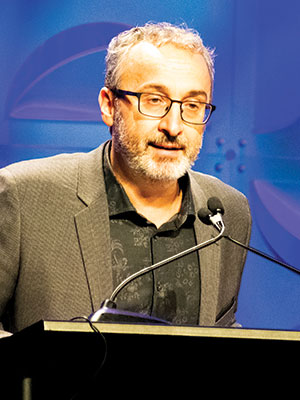Showcasing cutting-edge rheumatology research from around the world, six of the top abstracts submitted for this year’s Annual Meeting were presented during Monday’s Plenary II session.
Development of Ultrasound Detectable Arthritis Among ACPA Positive Subjects with Musculoskeletal Symptoms: The Risk RA Prospective Study

The results of this prospective study suggest that certain anti-citrullinated protein antibodies (ACPA) fine specificities, human leukocyte antigen-shared epitope (HLA-SE), and tenosynovitis predicts the development of ultrasound-detectable arthritis in seropositive individuals with musculoskeletal symptoms who are at risk for RA.
“The aim of our study is to develop a prediction algorithm for arthritis development among ACPA-positive individuals with musculoskeletal complaints lacking both clinical and ultrasound detectable arthritis,” said Anca Catrina, MD, PhD, Professor and Senior Physician in the Unit of Rheumatology at Karolinska University Hospital in Stockholm, Sweden.
“Three other studies are currently available in individuals at risk for developing arthritis lacking clinically detectable arthritis; however, these studies are relatively small and have only limited data on serum biomarkers,” Dr. Catrina said. “We used a very stringent inclusion criteria, absence of ultrasound-detectable arthritis at inclusion. Despite this, as many as 28% of the included subjects developed ultrasound-detectable arthritis already after a median follow-up of 18 months. We describe several predictors that might help to identify individuals at high risk for arthritis development in clinical practice.”
Dr. Catrina said their goal now is to develop a prediction algorithm that will allow identification of high-risk individuals, allowing adequate selection of candidates for future interventional clinical studies.
Methotrexate in Patients with Hand Erosive Osteoarthritis Refractory to Usual Treatments: A Randomized, Double-blind, Placebo-controlled Trial

In this randomized, double-blind, placebo-controlled study, researchers report that methotrexate did not demonstrate superior efficacy over placebo for pain relief and function evolution at three and 12 months in patients with erosive hand osteoarthritis, but did significantly reduce the progression of joint damage over placebo and seems to facilitate bone remodeling in these patients.
For this study, 64 patients with erosive hand OA in the study were randomized into two groups — a dose of 10mg of methotrexate per week or a placebo. The study’s primary endpoint was pain assessment at three months. Secondary endpoints were clinical features, including pain measured on a Visual Analog Scale (VAS), radiographic features, and magnetic resonance imaging (MRI) at 12 months.
“It is possible that we have to treat earlier if we want to have an effect on pain; however, our results show a structural effect of the treatment that facilitates bone remodeling and seems to slow the erosive structural progression of digital osteoarthritis with a seemingly more pronounced effect in patients with early lesions,” said study lead author Christian Roux, MD, PhD, Head of the Joint Unit in the Rheumatology Department at Cote d’Azur University in France. “I think this is a major point, as the main complaint for people is the deformity linked to structural evolution in this disease. Our study’s results should encourage new studies to be conducted.”
Six-week Treatment with Low-dose Prednisolone in Patients with Painful Hand Osteoarthritis (HOPE): Results from a Randomized Double-blind Placebo-controlled Trial

This trial demonstrated that six-week treatment with low-dose oral prednisolone led to a substantial improvement of symptoms in patients with painful hand osteoarthritis and signs of inflammation.
“We included 92 patients who were randomized to receive prednisolone 10mg (46 patients) or placebo (46 patients) orally once daily for six weeks, followed by a two-week tapering scheme and six-week follow-up without study medication,” said Feline Kroon, MD, Department of Rheumatology, Leiden University Medical Center in The Netherlands.
The primary endpoint of the study was finger pain at six weeks on a visual analog scale.
“The results of our study provide clinicians with a new short-term treatment option for patients with hand OA who report a flare-up of their disease,” Dr. Kroon said. “However, the HOPE study only provides evidence for the effectiveness of a six-week course of 10mg prednisolone daily, and in light of the risk of complications, such as glucocorticoid-induced osteoporosis, prescription of prednisolone for prolonged periods of time in patients with hand osteoarthritis should be discouraged.”
After tapering the study medication, Dr. Kroon said that symptoms resumed baseline levels, and it is unknown whether further improvement would have been achieved with continued treatment, or whether timely suppression of inflammation can eventually alter the disease course.
The Prospective Open Label Preventive Approach to Congenital Heart Block with Hydroxychloroquine (PATCH) Study Demonstrates a Reduction in the Recurrence Rate of Advanced Block

This open label single-arm phase II clinical trial found that hydroxychloroquine (HCQ) significantly reduces the recurrence rate of congenital heart block (CHB) in subsequent pregnancies of women with anti-SSA/Ro antibodies, regardless of their health status.
For this trial, the researchers applied the Simon two‐stage optimal approach, which allows for early stopping due to absence of treatment efficacy, said Jill Buyon, MD, Professor of Medicine and Director of the Lupus Center at New York University School of Medicine/New York University Langone Health.
The trial included 19 patients in the first stage and 35 in the second. The protocol required HCQ initiation or maintenance at 400mg daily by 10 weeks’ gestation. Mothers underwent serial echocardiograms and had blood drawn during each trimester and at delivery for cord blood to measure antibody and HCQ levels.
In 33 pregnancies, CHB did not occur, Dr. Buyon reported, and two pregnancies resulted in a primary outcome. Thus, combining Stages I and Stage II, based on the primary analysis conducted according to an intent-to-treat analysis, 4 of 54 pregnancies (7.4%) exposed to 400mg HCQ resulted in advanced CHB.
“Our translational implications of the data from this prospective single arm clinical trial support the consideration of HCQ for secondary prevention of advanced conduction defects,” Dr. Buyon said. “Given the potential benefit of hydroxychloroquine, we suggest that testing all pregnancies for anti-Ro antibodies, regardless of maternal health, should be considered.”
UV Light Induces Acute Type I Interferon Production in the Skin and Blood, Which Is cGAS Dependent

The results from this study suggest that the presence of IFN-I signature in both the non-lesional skin as well as in peripheral blood cells, together with increased circulating IFNβ levels, provide a model by which skin exposure to UVB light drives systemic activation of the IFN-I response.
“In this study, we found that a single dose of UVB light is sufficient to stimulate a rapid and strong interferon response in both human and murine skin,” said Sladjana Skopelja-Gardner, PhD, Senior Fellow in the Division of Rheumatology at the University of Washington, Seattle.
“Relevant to the striking predilection of females for lupus, we found that the interferon response was exaggerated in the female skin,” she said. “Of great interest, besides the local response, we discovered that a single exposure to UVB light also stimulated a systemic response, i.e. an increased interferon signature in the blood cells as well as the kidney tissue.”
The researchers also demonstrated that both the skin and the blood early interferon responses to UV light were dependent on the DNA sensing pathway cGAS-STING. The requirement for cGAS was temporally regulated, Dr. Skopelja-Gardner said, and this pathway was important for both innate and adaptive immune cell recruitment to UV exposed skin.
“Our laboratory has previously developed and demonstrated efficacy of a cGAS inhibitor to attenuate the interferon response in a murine model,” she said. “Perhaps drugs of this class can be effective in preventing acute flares in lupus patients in response to UV light.”
A Phase 3 Randomized Controlled Trial of Anifrolumab in Patients with Moderate to Severe Systemic Lupus Erythematosus

In a phase II study of anifrolumab in SLE (MUSE), marked inhibition of the type I interferon pathway was seen. More significantly, clinical responses were very robust. Based on these results, the program moved to phase III and included two studies, TULIP 1 and TULIP 2. The studies’ goals are to reduce clinical activity with an acceptable safety profile, said Richard Furie, MD, Chief of the Division of Rheumatology at Northwell Health and Professor of Medicine at the Zucker School of Medicine at Hofstra/Northwell.
“The primary goal of the study was to demonstrate improvement in a composite responder index known as the SLE Responder Index (SRI),” Dr. Furie said. “Secondary endpoints evaluated effects on skin disease, arthritis, ability to taper steroids, and another clinically relevant end point known as the BILAG-Based Composite Lupus Assessment (BICLA).”
With several secondary endpoints, Dr. Furie said the effectiveness of anifrolumab needs to be judged not only by the results of TULIP 1, but also by MUSE and TULIP 2.
“Despite a failure to achieve the primary endpoint in TULIP 1, results from phase II and the other phase III study, TULIP 2, need to be incorporated in the decision-making process to determine whether the lupus community will see a new therapy approved,” he said.
